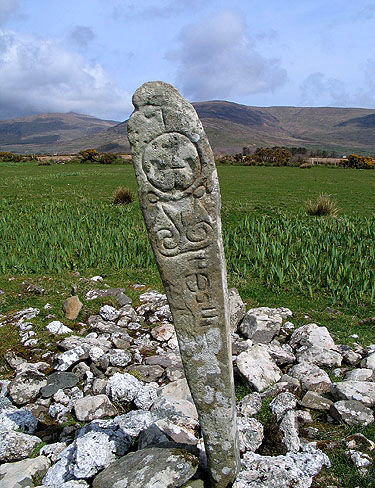Type: Ogham & Cross Inscribed
Townland: Cill Fhiontain Finten's Church

Kilfountain/'Kilfountan Church and Calluragh burial ground/Teampall Fionntain: A roughly D-shaped or sub-oval enclosure within which are the remains of an oratory and a rectangular hut, a cross-inscribed ogham stone and a bullaun stone' (Cuppage 1986, 302). The cross-inscribed ogham stone is 'standing in a pile of quartz rubble to the east of the ruined oratory' (Okasha and Forsyth 2001, 161)
MonumentFound: Standing at the site, probably in the same position it is in today, in the townland of Kilfountain and barony of Corkaguiney. (GPS coordinates -10.306496, 52.157768) Original: Find location probably original site Last Recorded: The stone is standing in a pile of quartz rubble to the east of the ruined oratory National Monuments Service Historic Environment viewer on www.archaeology.ie.
TextThe ogham inscription is 'on the lower part of the south-east angle of the stone, reading upwards' (Okasha and Forsyth 2001, 162). Macalister (1945, 179) notes that the scores of this inscription are pocked. He adds that 'there is a wide space between the Q and the DD (4 1/2 inches), but it has only two notches in the middle and there never were any more'.
The suggestion by Cuppage (1986, 304) and others that the I-scores have disappeared since Macalister's day is supported by the 3d data. 'There are traces of of what may be further letters before the E and at the top of the pillar but these are highly uncertain' (Okasha and Forsyth 2001, 163).
The second inscription is in half-uncial script and, along with the cross and design above it, was described by Macalister as cut, rather than pocked like the ogham scores. Cuppage (1986, 304) noted that only one line of text is visible beneath the design and reads upwards:
[F]INTEN. However, Macalister (1945, 179) has two lines of parallel text, the first reading down (SCI) and the second reading up (FINTEN): SANCTI FINTEN.
He also notes 'the way in which the initial F is turned sideways as though to form a pivot on which the two lines of the inscription hinge'. There are now only traces of a possible SCI and not enough of the F to be sure of its orientation.
Ogham: [ ̣ ̣ ? ̣ ̣]EQỌDD[I ̣ ̣ ? ̣ ̣] Half-uncial: [SCI( )] F̣INTEN.
CommentaryWhat little remains of the ogham inscription would appear to correspond with another possible personal name on CIIC 129. Cooldorragha, Co. Cork (VEQOANAI MAQI EQOD[...) (Macalister 1945, 127-8). EQODD[I] ech 'horse'? (McManus 1991, 122).
'The spelling Finten for the later Fintan is consevative and implies a comparatively early date, perhaps seventh- or early eighth century... While it is possible that a later reading of the text may have inspired the dedication of Kilfountain/Cill Fionntain, it is more likely that the text is a dedicatory one, recording the donation or dedication of the site to the eponymous saint, although to which of the many St Fintans is not known'.
A comparable case would be the stone probably inscribed SCI BRECANI, also in half-uncial, at Kilbrecan, Aran Mór (Okasha and Forsyth 2001, 163-4)..
Okasha/Forsyth/2001, 161: 'The stone was first recorded by Windele in September 1848 when it was standing in the graveyard. Windele described the stone as `Near its S E angle but a few feet from it' (Windele mSS 12.C.11, p. 416). It is not clear, however, if Windele was referring to the south-east angle of the oratory or the graveyard.
Petrie recorded the stone both `about ten feet from the north-east corner of the church' and `near the side of a road' ... It is not clear whether these descriptions refer to the same location or whether the stone was moved. Macalister's photograph ... suggests that the stone was then in roughly the position it occupies today'.
Cuppage et al/1986, 304: The upper part of the S face is occupied by an equal-armed cross with expanded terminals which is enclosed within a circle. This is surmounted by a scrolled crest, joined to the top of the circle by a short stem. Beneath the cross, but not pendant from it, is an elaborate design which ends in a pelta motif.
Directly below the circle, a wide curved band has been left in relief at each end of this. Pendant from each end are a curved line which runs to meet the edge of the stone and a 2nd line which develops into the pelta design. Another line, pendant from the centre of the band, extends a short distance between the latter'.
Okasha/Forsyth/2001, 162:
`Only the west face ... is decorated ... The upper part of this face contains an equal-armed cross set inside a circle; the cross has expanded terminals with the lower one joining on to the circle. Above the circle and joined to it by a small stem is a scrolled crest. Beneath the circle and separate from it is an elaborate design ending in a pelta motif. The design comprises a sunken field of inverted triangular shape with a concave upper edge.
A short stem issues from its lower apex. At the left and right apices is a large incised oval with a pendant `string' looping to the outer edge of the stone. Also pendant from each apex is a line which runs down to form the pelta. In addition, two short lines curve upwards and outwards from the right oval towards the edge of the stone'.
Emmy Van Den Berg